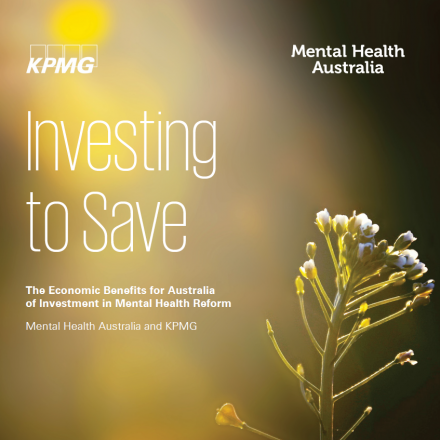2015 Federal Budget - Mental Health Australia Summary
Mental Health Measures
Government commits to new National Mental Health Plan
The Australian Government (the Government) has announced that it will work in collaboration with the states and territories to develop a new national mental health plan. The plan will inform better planning, targeting and integration of services at a national and regional level, and facilitate an integrated approach to mental health and suicide prevention activities. (Health PBS, pg102)
When Minister Ley released the National Mental Health Commission’s Review some weeks ago, she also announced a new Expert Reference Group (ERG) to advise the Government on the implementation of the Review’s recommendations. We now understand that the membership of the ERG will be announced in the next fortnight.
National Mental Health Commission
The National Mental Health Commission has received renewed funding for three years.
Mental Health Nurse Incentive Programme – continuation
While not specifically mentioned in the Budget papers, we have confirmed that the Mental Health Nurse Incentive Programme (MNHIP) has been continued. We are pleased that this program has now been made ongoing, rather than living on year-by-year extensions. Despite this good news, MNHIP will be subject to the same uncertainty as other services funded by the Commonwealth as the Government considers its response to the Commission’s Review.
Improved mental health support in the bush
The Government will provide $20.0 million in 2015-16 to extend access to social and mental health services in some drought affected communities. Assistance will continue to be delivered through the existing Family Support and Targeted Community Care (Mental Health) programme, with an extension to additional regions experiencing severe and prolonged drought. (Budget Paper 2, pg 59)
Measures of interest in the Health portfolio
Real cuts to mental health grants – continuation of the ‘indexation pause’
Last year, the Government froze indexation across 78 government programmes, including a range of mental health programmes. This budget extends that freeze until the end of 2019-20. The exact impact on mental health services is unclear. (Budget Paper 2, pg 71)
The Health Portfolio Budget Statement also reveals that approximately $34 million less will be spent on mental health services over four years than the Government forecast at this time last year. This represents only 1.2 per cent of overall spending on those programs; we believe the change is due to updates to forecasts of CPI and other indexation parameters. (Health PBS pg 99, compared to last year’s Health PBS pg 115)
Medical Research Future Fund to go ahead
The Medical Research Future Fund (MRFF) will go ahead, but very little information is available on what research will be funded. A range of savings measures – including substantial measures relating to the Pharmaceutical Benefits Scheme, the Medicare Benefits Schedule and departmental grants – in the health portfolio are flagged for redistribution into the MRFF.
Pharmaceutical Benefits Scheme (PBS) changes
The widely reported changes to the PBS were not included in the Budget. We understand these changes, which are likely to reduce the cost of a range of generic medicines, including Duloxetine for depression and Quetiapine for a range of mental health conditions, are subject to further negotiation with the pharmaceutical sector.
Measures of interest in the Social Services portfolio
Actuarial approach to welfare
The Government has committed $20.7 million over four years to develop a detailed annual actuarial valuation of the lifetime liability of Australia’s welfare system, including identifying groups of people most at risk of welfare dependency and the factors that lead to long term dependency. (Budget Paper 2, pg 161).
Mental Health Australia will provide further analysis of this initiative in the coming days.
Carer support services — national gateway
The Government will provide $33.7 million over four years from 2015-16 to create a national gateway for carers to access information, support and referral to carer-specific supports and services. (Budget Paper 2, pg150)
It is unclear how this interacts with the NDIS, including services funded under the Information, Linkages and Capacity Building initiative (formerly ‘Tier 2’ services).
Continued commitment to the National Disability Insurance Scheme
The Budget confirmed the earlier announcement of an early NDIS rollout for 2,000 children in the Nepean/Blue Mountains region of NSW, from 1 September 2015. The Government will also provide $143 million over four years for an Information and Communication Technology system for the National Disability Insurance Agency to support the full implementation of the NDIS. (Budget Paper 2 pg163-4)
It is still unclear if the Government will provide any funding to support upgrading service providers’ IT systems.
Changes to welfare for young job seekers
The Government has announced it will reverse the 2014-15 Budget measure Stronger Participation Incentives for Job Seekers under 30, and instead require young people under 25 years of age without significant barriers to employment to actively seek work for four weeks (rather than six months) before receiving income support payments.
Participants in Disability Employment Services and jobactive participants who are assessed as requiring greater assistance to obtain employment, job seekers who are principal carer parents, and young people leaving state care will be exempt from this waiting period.
Other significant announcements
Youth Employment Strategy
One of the headlines of the Budget is a Youth Employment Strategy. As part of this, the Government will provide $105.7 million over five years to improve employment, educational and social outcomes for parents and young people who are unemployed, have a mental health condition, are refugees or are vulnerable migrants. This funding includes:
- $55.2 million over five years for community and non-government organisations to implement up to 40 trials to identify and engage early with disadvantaged youth who have multiple barriers to employment and support them to engage with the labour market;
- $19.4 million over four years for two employment support trials to help improve employment outcomes for young people up to the age of 25 with mental illness, who are at risk of disengaging from education and/or at risk of long term welfare dependency;
- $22.1 million over four years to support young refugees and other vulnerable young migrants to build skills and confidence to equip them to participate in education or work; and
- $8.9 million over four years for early intervention assistance in ten locations with high numbers of disadvantaged parents, to ensure that parents with barriers to employment are job ready. A two year trial commencing 1 April 2016 will extend eligibility to parents not on income support, with participation on a voluntary basis.
This measure will assist a range of vulnerable Australians, including those with a mental illness.
| Attachment | Kind | Size |
|---|---|---|
| 70.08 KB |




